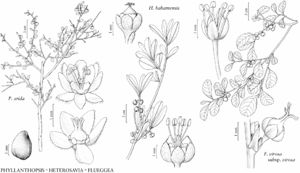Heterosavia
Brittonia 60: 152. 2008.
| Taxon | Illustrator ⠉ | |
|---|---|---|
 | Phyllanthopsis arida Flueggea virosa subsp. virosa Heterosavia bahamensis | Barbara Alongi Barbara Alongi Barbara Alongi |
Shrubs or trees, dioecious, hairy, glabrescent, hairs simple; branching not phyllanthoid. Leaves persistent, alternate, simple, all well developed; stipules persistent; blade margins entire. Inflorescences unisexual, staminate glomes, pistillate flowers solitary. Pedicels: staminate rudimentary, pistillate present. Staminate flowers: sepals 5, distinct; petals 5; nectary extrastaminal, annular, crenate [entire]; stamens 5; filaments distinct or connate basally [to 1/2 length]; connectives not extending beyond anthers; pistillode 3-divided to base or nearly so. Pistillate flowers: sepals persistent, 5, distinct; petals 5; nectary annular, crenate [entire]; pistil 3 (–4) -carpellate; styles (3–) 4, distinct, 2-fid 1/2 length. Fruits capsules. Seeds 2 per locule, rounded-trigonous; seed-coat dry, smooth; caruncle absent.
Distribution
Fla., West Indies (Greater Antilles)
Discussion
Species 4 (1 in the flora).
Molecular phylogenetic analyses have shown that Savia as traditionally recognized is polyphyletic and should be treated as three genera, each assigned to a different tribe (H. Kathriarachchi et al. 2005; P. Hoffmann et al. 2006; Hoffmann 2008). Heterosavia, which includes the species formerly included in the Caribbean Savia sect. Heterosavia, belongs to Phyllantheae Dumortier and is sister to Flueggea.
Selected References
Lower Taxa
"connate" is not a number."/2" is not declared as a valid unit of measurement for this property.